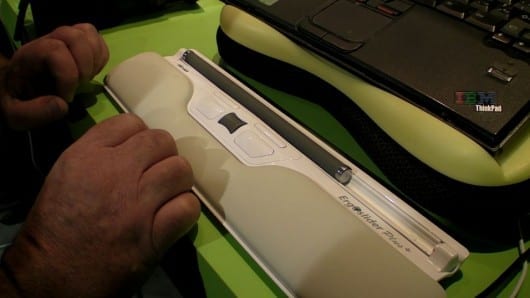The coating could lead to breathable garments to protect soldiers and scientists from chemicals, and advanced waterproof paints that dramatically reduce drag on ships.
A nanoscale coating that’s at least 95 percent air repels the broadest range of liquids of any material in its class, causing them to bounce off the treated surface, according to the University of Michigan engineering researchers who developed it.
In addition to super stain-resistant clothes, the coating could lead to breathable garments to protect soldiers and scientists from chemicals, and advanced waterproof paints that dramatically reduce drag on ships.
Droplets of solutions that would normally damage either your shirt or your skin recoil when they touch the new “superomniphobic surface.”
“Virtually any liquid you throw on it bounces right off without wetting it. For many of the other similar coatings, very low surface tension liquids such as oils, alcohols, organic acids, organic bases and solvents stick to them and they could start to diffuse through and that’s not what you want,” said Anish Tuteja, assistant professor of materials science and engineering, chemical engineering and macromolecular science and engineering.
Tuteja is the corresponding author of a paper on the coating published in the current issue of the Journal of the American Chemical Society.
She and her colleagues tested more than 100 liquids and found only two that were able to penetrate the coating. They were chlorofluorocarbons—chemicals used in refrigerators and air conditioners. In Tuteja’s lab, in a demonstration, the surface repelled coffee, soy sauce and vegetable oil, as well as toxic hydrochloric and sulfuric acids that could burn skin. Tuteja says it’s also resistant to gasoline and various alcohols.
To apply the coating, the researchers use a technique called electrospinning that uses an electric charge to create fine particles of solid from a liquid solution. So far, they’ve coated small tiles of screen and postage-stamp-sized swaths of fabric.
The coating is a mixture of rubbery plastic particles of “polydimethylsiloxane,” or PDMS, and liquid-resisting nanoscale cubes developed by the Air Force that contain carbon, fluorine, silicon and oxygen. The material’s chemistry is important, but so is its texture. It hugs the pore structure of whatever surface it’s being applied to, and it also creates a finer web within those pores. This structure means that between 95 and 99 percent of the coating is actually air pockets, so any liquid that comes in contact with the coating is barely touching a solid surface.
Because the liquid touches mere filaments of the solid surface, as opposed to a greater area, the developed coating can dramatically reduce the intermolecular forces that normally draw the two states of matter together. These Van der Waals interaction forces are kept at a minimum.
“Normally, when the two materials get close, they imbue a small positive or negative charge on each other, and as soon as the liquid comes in contact with the solid surface it will start to spread,” Tuteja said. “We’ve drastically reduced the interaction between the surface and the droplet.”
With almost no incentive to spread, the droplets stay intact, interacting only with molecules of themselves, maintaining a spherical shape, and literally bouncing off the coating.
The Latest Streaming News: Nanoscale coating updated minute-by-minute
Bookmark this page and come back often
Latest NEWS
Latest VIDEO









